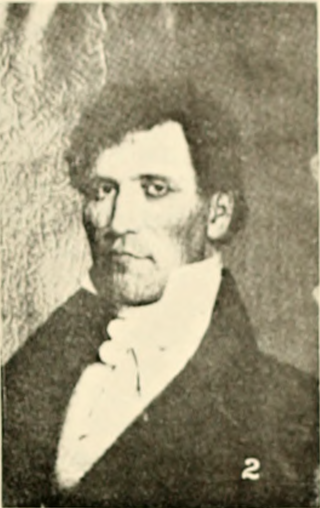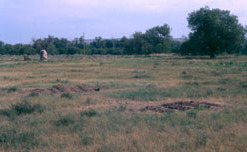Related Research Articles

Manuel Lisa, also known as Manuel de Lisa, was a Spanish citizen and later, became an American citizen who, while living on the western frontier, became a land owner, merchant, fur trader, United States Indian agent, and explorer. Lisa was among the founders, in St. Louis, of the Missouri Fur Company, an early fur trading company. Manuel Lisa gained respect through his trading among Native American tribes of the upper Missouri River region, such as the Teton Sioux, Omaha and Ponca.

The Arikara War was a military conflict between the United States and Arikara in 1823 fought in the Great Plains along the Upper Missouri River in the Unorganized Territory. For the United States, the war was the first in which the United States Army was deployed for operations west of the Missouri River on the Great Plains. The war, the first and only conflict between the Arikara and the U.S., came as a response to an Arikara attack on U.S. citizens engaged in the fur trade. The Arikara War was called "the worst disaster in the history of the Western fur trade".

The American Fur Company (AFC) was founded in 1808, by John Jacob Astor, a German immigrant to the United States. During the 18th century, furs had become a major commodity in Europe, and North America became a major supplier. Several British companies, most notably the North West Company (NWC and the Hudson's Bay Company, were eventual competitors against Astor and capitalized on the lucrative trade in furs. Astor utilized a variety of commercial strategies to become one of the first trusts in American business and a major competitor to the British commercial dominance in North American fur trade. Expanding into many former British fur-trapping regions and trade routes, the company grew to monopolize the fur trade in the United States by 1830, and became one of the largest and wealthiest businesses in the country.

Fort Union Trading Post National Historic Site is a partial reconstruction of the most important fur trading post on the upper Missouri River from 1829 to 1867. The fort site is about two miles from the confluence of the Missouri River and its tributary, the Yellowstone River, on the Dakota side of the North Dakota/Montana border, 25 miles from Williston, North Dakota.
Fort Kiowa, officially Fort Lookout and also called Fort Brazeau/Brasseaux, was a 19th-century fur trading post located on the Missouri River between modern Chamberlain, South Dakota, and the Big Bend of the Missouri.

Kenneth McKenzie was nicknamed the "King of the Missouri", for as a fur trader for American Fur Company in the upper Missouri River valley, he controlled a territory larger than most European nations.
Fort Lisa (1812–1823) was established in 1812 in what is now North Omaha in Omaha, Nebraska by famed fur trader Manuel Lisa and the Missouri Fur Company, which was based in Saint Louis. The fort was associated with several firsts in Nebraska history: Lisa was the first European farmer in Nebraska; it was the first settlement by American citizens set up in the then-recent Louisiana Purchase; Lisa's wife was the first woman resident of European descent in Nebraska; and the first steamboat to navigate Nebraska waters, the Western Engineer, arrived at Fort Lisa in September 1819.

Pierre Chouteau Jr., also referred to as Pierre Cadet Chouteau, was an American merchant and a member of the wealthy Chouteau fur-trading family of Saint Louis, Missouri.

Russel Farnham was an American frontiersman, explorer, and fur trader. An agent of John Jacob Astor's American Fur Company, he oversaw fur trading in the Great Lakes region throughout the 1810s and 1820s. A member of the Pacific Fur Company headed by Wilson P. Hunt during 1810–1812, he is also the first American to semi-circumnavigate the world traveling by foot from Fort Astoria to St. Petersburg, Russia, to New York City.

Fort Pierre Chouteau, also just Fort Pierre, was a major trading post and military outpost in the mid-19th century on the west bank of the Missouri River in what is now central South Dakota. Established in 1832 by Pierre Chouteau, Jr. of St. Louis, Missouri, whose family were major fur traders, this facility operated through the 1850s.
The first Fort Lisa (1810-1812), also known as the Fort Manuel Lisa Trading Post, Fort Manuel or Fort Mandan, was started by the notable fur trader Manuel Lisa of the Missouri Fur Company in 1809. This fort was likely where Sacagawea died; she had been the guide for the Lewis and Clark Expedition. Fort Lisa superseded Fort Raymond as the uppermost post of the Missouri Fur Company on the Missouri River. In 1812 Lisa built a replacement fort downriver near present-day North Omaha, Nebraska, which he also named Fort Lisa.
Fort Berthold was the name of two successive forts on the upper Missouri River in present-day central-northwest North Dakota. Both were initially established as fur trading posts. The second was adapted as a post for the U.S. Army. After the Army left the area, having subdued Native Americans, the fort was used by the US as the Indian Agency for the regional Arikara, Hidatsa, and Mandan Affiliated Tribes and their reservation.
The Missouri Fur Company was one of the earliest fur trading companies in St. Louis, Missouri. Dissolved and reorganized several times, it operated under various names from 1809 until its final dissolution in 1830. It was created by a group of fur traders and merchants from St. Louis and Kaskaskia, Illinois, including Manuel Lisa and members of the Chouteau family. Its expeditions explored the upper Missouri River and traded with a variety of Native American tribes, and it acted as the prototype for fur trading companies along the Missouri River until the 1820s.

The fur trade in Montana was a major period in the area's economic history from about 1800 to the 1850s. It also represents the initial meeting of cultures between indigenous peoples and those of European ancestry. British and Canadian traders approached the area from the north and northeast focusing on trading with the indigenous people, who often did the trapping of beavers and other animals themselves. American traders moved gradually up the Missouri River seeking to beat British and Canadian traders to the profitable Upper Missouri River region.
This timeline of South Dakota is a list of events in the history of South Dakota by year.

Charles Larpenteur (1803–1872) was an American fur trader whose memoir and diary frequently have been used as sources about fur trade history.
Benito Andres Vázquez, was a Spanish soldier and later, became an American fur trader who, while living on the western frontier, became a merchant and explorer. He is the father of fur trader Louis Vasquez.

Alexander Culbertson (1809–1879), was an American fur trader who founded Fort Benton, Montana, and was a special government agent who played an important role in the negotiations leading to the 1851 treaty of Fort Laramie. Later, Culbertson and his wife Natawista Iksina negotiated with the Blackfoot Confederacy to let the northern Pacific railroad survey of 1853 continue unharmed.

Joseph Marie LaBarge was an American steamboat captain, most notably of the steamboats Yellowstone, and Emilie, that saw service on the Mississippi and Missouri rivers, bringing fur traders, miners, goods and supplies up and down these rivers to their destinations. During much of his career LaBarge was in the employ of the American Fur Company, a giant in the fur trading business, before building his own steamboat, the Emilie, to become an independent riverman. During his career he exceeded several existing speed and distance records for steamboats on the Missouri River. Passengers aboard his vessels sometimes included notable people, including Abraham Lincoln. LaBarge routinely offered his steamboat services gratis to Jesuit missionaries throughout his career.

The Spread Eagle was a steam-driven sidewheel riverboat that transported passengers, goods and supplies to the forts and trading posts along the Missouri River between 1857–1864. It was constructed and launched at Brownsville, Pennsylvania. The vessel was a wooden hull packet, 210 feet (64 m) long, with a beam of 36 feet (11 m), a draft of 6 feet (1.8 m), and was rated at 389 tons. It was powered by two steam engines with 3 boilers each, at 40 inches (1,000 mm) in diameter and 24 feet (7.3 m) in length. The Spread Eagle was constructed by Captain Benjamin Johnson who sold the vessel to the American Fur Company upon her arrival at Saint Louis, Missouri. Commanded by captain Bailey, she was once engaged in a race along the Missouri from St. Louis to Fort Benton where she rammed her opponent.
References
Notes
- 1 2 3 Chittenden 1902, vol. 1, pp. 323-325.
- 1 2 3 Jones 1966, pp. 107-108.
- 1 2 Barbour 2001, p. 11.
- ↑ Wishart 1979, pp. 49-50.
- ↑ Barbour 2001, p. 17.
- ↑ Wishart 1979, p. 53.
- ↑ Barbour 2001, pp. 40-43.
- ↑ Chittenden 1902, vol. 3, p. 953.
- ↑ Robertson 1999, pp. 138, 151.
- ↑ "Columbia Fur Company Forts". Fort Wiki. Retrieved 2017-11-30.
- ↑ Chittenden 1902, vol. 3, p. 952.
- 1 2 Chittenden 1902, vol. 3, p. 957.
- ↑ Wishart 1979, map, p. 49.
- ↑ Chittenden 1902, vol. 3, p. 965.
Cited literature
- Barbour, Barton H. (2001). Fort Union and the upper Missouri fur trade . Norman: University of Oklahoma Press.
- Chittenden, Hiram Martin (1902). The American Fur Trade of the Far West. New York: Francis P. Harper.
- Jones, Evans (1966). Citadel in the Wilderness. Minneapolis: University of Minnesota Press.
- Robertson, Roland G. (1999). Competitive Struggle: America's Western Fur Trading Posts, 1764-1865. Caldwell, Idaho: Caxton Press.
- Wishart, David J. (1979). The Fur Trade of the American West 1807-1840. University of Nebraska Press.